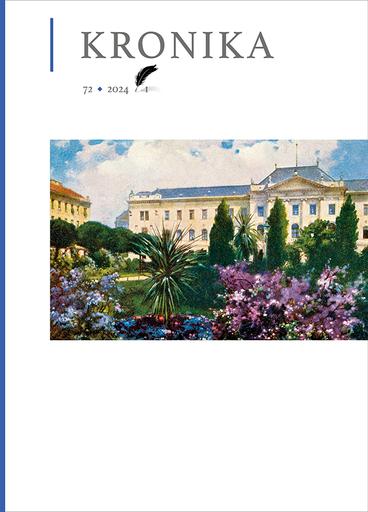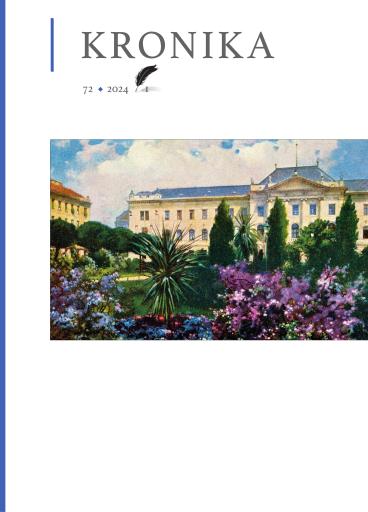/
Serijske publikacije
/
Kronika: časopis za slovensko krajevno zgodovino
Začetki preučevanja zbirke orožjav Narodnem muzeju Slovenije


To delo avtorja Tomaž Lazar je ponujeno pod Creative Commons Priznanje avtorstva-Deljenje pod enakimi pogoji 4.0 Mednarodna
Datoteke (1)

Opis
The study of historical arms and armour has no firmly established tradition in Slovenian scholarship. This may be attributed to various factors – on the one hand, the widely entrenched notions of Slovenia’s past reduced to a mythologised nation of peace-loving country folk, and on the other hand, the lack of representative arms and armour collections belonging to noble elites, such as may be found in the neighbouring political centres. A rather unreflective approach to military historical heritage could be observed during the formative period of the Carniolan Provincial Museum in Ljubljana, the precursor to the later National Museum, where this particular field remained largely uncharted until the end of World War II. Ljubljana’s museum experts ultimately recognised the true value of their arms and armour collection only towards the end of the 1950s, to a considerable extent or even mainly thanks to the interest of outside observers and foreign connoisseurs like the Viennese curator Dr Bruno Thomas. Within the National Museum, this shift finally stimulated the creation of a curatorial post devoted to arms and armour. Its tasks were entrusted to Ferdinand Tancik, Slovenia’s first specialist in the military heritage of the premodern era and, despite his brief career, a surprisingly influential local pioneer in arms and armour studies.
Metapodatki (13)
- identifikatorhttps://hdl.handle.net/11686/59805
- naslov
- Začetki preučevanja zbirke orožjav Narodnem muzeju Slovenije
- Early studies of the arms and armour collection in the National Museum of Slovenia
- ustvarjalec
- Tomaž Lazar
- soavtor
- Miha Preinfalk (odg. ur.)
- Manca Gašperšič (prev.)
- Rok Janežič (lekt.)
- predmet
- Narodni muzej Slovenije
- orožje
- oklepi
- Bruno Thomas
- Ferdinand Tancik
- vojaška zgodovina
- kulturna dediščina
- zbirateljstvo
- starine
- opis
- Preučevanje historičnega orožja v slovenskem prostoru nima dolge strokovne tradicije. K temu so pripomogli različni razlogi – po eni strani splošno zakoreninjene predstave o nacionalni zgodovini Slovencev kot mitologiziranega naroda miroljubnih poljedelcev, po drugi strani pomanjkanje reprezentativnih plemiških zbirk starega orožja, kot so se izoblikovale v političnih središčih naše soseščine. Neizdelan odnos do vojaškozgodovinske dediščine se je pokazal že ob ustanavljanju Kranjskega deželnega muzeja v Ljubljani, kjer je to področje ostalo tako rekoč neobdelano vse do konca druge svetovne vojne. Ljubljanski muzealci so vrednost muzejske zbirke orožja zares prepoznali šele proti koncu petdesetih let 20. stoletja, očitno predvsem zaradi interesa zunanjih opazovalcev in tujih izvedencev, kot je bil dunajski kustos dr. Bruno Thomas. Šele ta premik je v Narodnem muzeju spodbudil izoblikovanje samostojnega kustodiata za orožje in bojno opremo. Njegov nosilec je postal Ferdinand Tancik, prvi specialist za vojaško dediščino starejših obdobij in kljub kratki karieri presenetljivo vpliven pionir slovenskega orožjeslovja.
- The study of historical arms and armour has no firmly established tradition in Slovenian scholarship. This may be attributed to various factors – on the one hand, the widely entrenched notions of Slovenia’s past reduced to a mythologised nation of peace-loving country folk, and on the other hand, the lack of representative arms and armour collections belonging to noble elites, such as may be found in the neighbouring political centres. A rather unreflective approach to military historical heritage could be observed during the formative period of the Carniolan Provincial Museum in Ljubljana, the precursor to the later National Museum, where this particular field remained largely uncharted until the end of World War II. Ljubljana’s museum experts ultimately recognised the true value of their arms and armour collection only towards the end of the 1950s, to a considerable extent or even mainly thanks to the interest of outside observers and foreign connoisseurs like the Viennese curator Dr Bruno Thomas. Within the National Museum, this shift finally stimulated the creation of a curatorial post devoted to arms and armour. Its tasks were entrusted to Ferdinand Tancik, Slovenia’s first specialist in the military heritage of the premodern era and, despite his brief career, a surprisingly influential local pioneer in arms and armour studies.
- založnik
- Zveza zgodovinskih društev Slovenije
- datum
- 2024
- tip
- besedilo
- identifikator
- https://doi.org/10.56420/Kronika.72.1.11
- jezik
- Slovenščina
- jeDelOd
- pravice
- licenca: ccBySa
